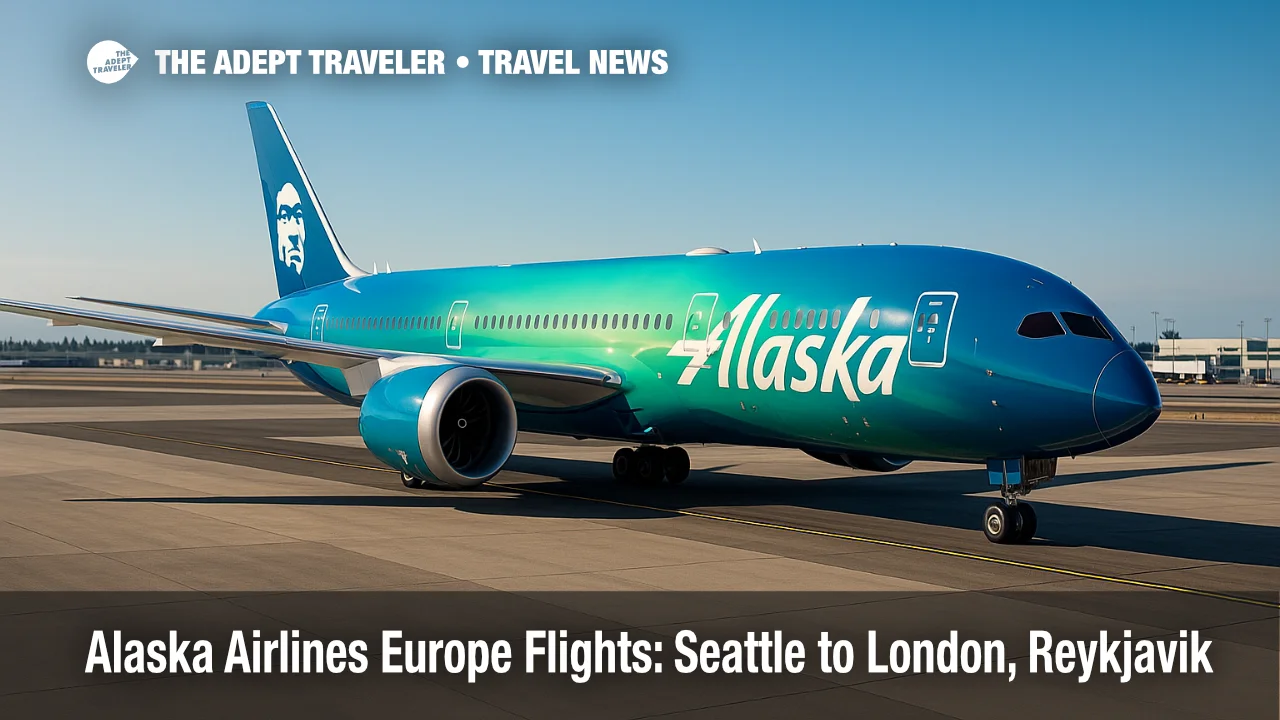Alaska Airlines Europe Flights: Seattle to London, Reykjavik

Alaska Airlines is turning Seattle-Tacoma International Airport (SEA) into a true global gateway. The carrier confirmed daily Boeing 787-9 service to London Heathrow (LHR) and a summer-only Boeing 737-8 Max link to Keflavik International Airport (KEF) in Reykjavik, both due to launch in spring 2026 once government approvals clear. The moves mark the fourth and fifth of at least twelve nonstop international routes Alaska aims to operate from its hometown hub by 2030, underscoring a rapid push into long-haul markets.
Key Points
- Why it matters: Seattle gains nonstop access to two high-demand European capitals.
- Travel impact: New flights add 2,500 weekly transatlantic seats and fresh mileage-earning options via Oneworld.
- What's next: Tickets go on sale this fall after final regulatory sign-off.
- Fleet growth: Up to 17 Dreamliners will carry the new aurora-themed livery.
- Cabin upgrades: Airbus A330s get lie-flat seats and premium economy by 2027.
Snapshot
By May 2026 Alaska will fly SEA-LHR daily year-round with 34-suite business-class cabins, positioning itself against Delta and British Airways on the airport pair that already draws more than 400 travelers a day. A three-month SEA-KEF season will follow, tapping demand for Iceland's outdoor adventures and convenient onward connections on Icelandair. Both routes align with Alaska's strategy of leveraging Oneworld partnerships for seamless Europe access while keeping a narrow-body cost base where feasible.
Background
Alaska Airlines, historically a West Coast specialist, accelerated international growth after joining Oneworld in 2021. It launched Tokyo Narita International Airport (NRT) in May 2025, will start Seoul Incheon International Airport (ICN) on September 12, and has Rome-Fiumicino International Airport (FCO) slated for 2026. Its first four Boeing 787-9 Dreamliners arrived this year; thirteen more are on order. The carrier's new livery, inspired by the northern lights, keeps the iconic Alaska Native face on narrow-body jets while giving wide-bodies sweeping blue-and-green gradients that match the airline's "global era" messaging.
Latest Developments
London Service Details
Alaska will operate the 4,791-mile route to London Heathrow with a three-class Dreamliner offering enclosed business suites, a 24-seat premium economy cabin, and 220 main-cabin seats. Flights will depart SEA in the early evening, arriving in London mid-afternoon the following day; the westbound returns will leave LHR late morning, enabling same-day U.S. connections. Schedules will post at alaskaair.com/london?utm_source=adept.travel later this year, with introductory fares expected to undercut joint-venture competitors.
Reykjavik Route Overview
The 3,571-mile Reykjavik link will run five times weekly from late May through early September using 737-8 Max aircraft configured with 184 seats. Alaska projects strong outbound leisure demand and inbound feed from Iceland's growing cruise-and-tour market. Keflavik's midnight-sun arrivals allow easy transfers to domestic flights and Nordic capitals, expanding options for West Coast travelers without a change of planes in the Midwest or East Coast.
Analysis
Alaska's Europe push signals a strategic pivot from feeder-to-partner status within Oneworld. By planting its own flag in marquee transatlantic markets the airline gains pricing power, Frequent Flyer loyalty stickiness, and airport slot leverage. London Heathrow remains the ultimate trophy; daily Dreamliner service grants Alaska corporate clients a premium option that can be bundled with West Coast shuttles, shielding revenue from Delta's SEA build-up. The seasonal Reykjavik experiment carries less risk, pairing lower-cost narrow-body economics with booming Iceland tourism. Further growth hinges on Dreamliner deliveries and bilateral rights. Rome, Seoul, Tokyo, and now London place Alaska in direct competition with alliance partners, but shared metal-neutral agreements should mitigate conflict while broadening connection flows. Upgraded Airbus A330 cabins will align onboard standards across the fleet, critical as Alaska courts high-yield travelers who previously chose legacy carriers. Investors will watch unit-revenue performance closely; early load-factor strength on Narita hints at latent demand Alaska can tap without deep discounting. Operationally, the move stretches SEA's international facilities but dovetails with the port authority's North Satellite modernization, supporting Alaska's claim that it can scale safely while preserving on-time performance.
Final Thoughts
Alaska Airlines Europe flights mark the next chapter in the carrier's evolution from regional powerhouse to truly global player. If the London and Reykjavik launches perform to forecast, expect additional Dreamliner announcements that solidify Seattle's role as America's newest West Coast bridge to Europe and Asia while reinforcing Alaska's long-term brand promise of care, value, and adventure.
Sources
- Alaska Airlines continues international expansion with new flights to London and Reykjavik from Seattle, Alaska Airlines Newsroom
- Alaska Airlines adds London and Iceland routes, unveils new 787 livery, The Points Guy
- Alaska Airlines announces a new look and two new intercontinental flights from Seattle, The Seattle Times
- Alaska Airlines Launching London And Iceland Flights, Unveils New 787 Look For Global Push, View from the Wing
